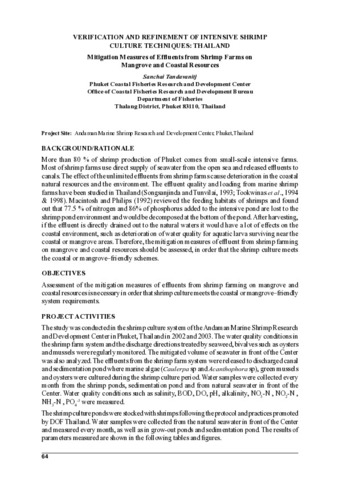Mitigation measures of effluents from shrimp farms on mangrove and coastal resources.
- Global styles
- MLA
- Vancouver
- Elsevier - Harvard
- APA
- Help
Share
นามธรรม
More than 80 % of shrimp production of Phuket comes from small-scale intensive farms. Most of shrimp farms use direct supply of seawater from the open sea and released effluents to canals. The effect of the unlimited effluents from shrimp farms cause deterioration in the coastal natural resources and the environment. The effluent quality and loading from marine shrimp farms have been studied in Thailand (Songsanjinda and Tunvilai, 1993; Tookwinas et al., 1994 & 1998). Macintosh and Philips (1992) reviewed the feeding habitats of shrimps and found out that 77.5 % of nitrogen and 86% of phosphorus added to the intensive pond are lost to the shrimp pond environment and would be decomposed at the bottom of the pond. After harvesting, if the effluent is directly drained out to the natural waters it would have a lot of effects on the coastal environment, such as deterioration of water quality for aquatic larva surviving near the coastal or mangrove areas. Therefore, the mitigation measures of effluent from shrimp farming on mangrove and coastal resources should be assessed, in order that the shrimp culture meets the coastal or mangrove–friendly schemes.
การอ้างอิง
Tandavanitj, S. (2004). Mitigation measures of effluents from shrimp farms on mangrove and coastal resources. In: Promotion of mangrove-friendly shrimp aquaculture in Southeast Asia (pp. 64-66). Tigbauan, Iloilo, Philippines: Aquaculture Department, Southeast Asian Fisheries Development Center.
Type
Meeting report


